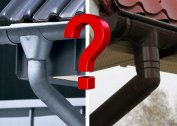Blockage in sewer pipes is a fairly common problem that affected everyone. The reason can be various factors from improper installation of the system to obstruction by a large object. Each of them can be dealt with, knowing only 3 points:
- Localization of blockage;
- View;
- Cleaning Methods.
Clog localization
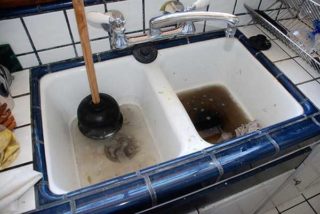 Determining the location of the blockage will help to more accurately select the necessary methods or means to eliminate it.
Determining the location of the blockage will help to more accurately select the necessary methods or means to eliminate it.
The most frequent areas of pollution:
- Located closer to the drain hole - siphon or elbow;
- Points of transition of the internal sewerage to the external;
- 50-60 cm before tapping into a common trunk.
Professionals can determine the location of the cork using a special cable with video surveillance. But you can do without such devices.
First of all, it is necessary to pay attention to the operation of the drainage system as a whole. In case of stagnation of water in all plumbing, it is necessary to call a specialist, since the riser is clogged. If problems arise only, for example, in the sink, proceed to the next step - turn on the water. Did the overflow begin immediately or after a couple of seconds? This indicates that the upper part of the sewer canal is clogged (siphon or area located immediately after it). Is water going fine for a while? The blockage is deeper.
Views
Blockages are divided into 3 types, based on the reason for the poor passage of pipes.
Mechanical
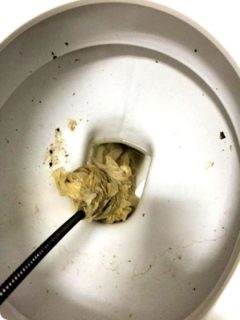 The emergence of this blockage contributes to neglect of the rules of operation. It occurs due to the overlap of the pipe passage with a large object. The most frequent place of localization is the upper sections of the pipeline, or bends.
The emergence of this blockage contributes to neglect of the rules of operation. It occurs due to the overlap of the pipe passage with a large object. The most frequent place of localization is the upper sections of the pipeline, or bends.
Remedies: The solution to the problem is quite simple, it is necessary to extract the cause of the blockage. For this, rubber gloves and a pair of hands will be enough. In some cases, a plunger, a plumbing cable or a metal ruff will help. The last two should be used only in case of overlapping by any easily collapsing object, for example, a large accumulation of paper. Otherwise, you run the risk of pushing the cause of the blockage deeper and getting it will be more problematic.
Using a plunger, you need to seal the overflow hole so that water does not leak. We press the plunger to the drain hole and jerkily pump air up and down until the water passes. For better grip, it is advised to lubricate the edges of the plunger with Vaseline. This method is suitable only for pipes with a small diameter.
The cable is introduced gradually into the pipe with rotational movements. It is recommended to rotate clockwise both when inserting and when removing the tool. End the cleaning session is the use of chemicals. There will be no problems in working with a plumbing cable, but for greater convenience you can purchase a special sleeve with which there will be less twisting.
Operational
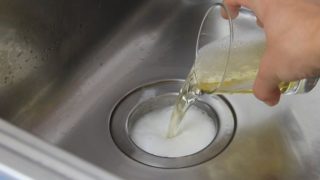 Appears as a result of long accumulating household deposits (grease, soap, etc.), which narrow the lumen of the pipe and prevent the free passage of water. The situation is aggravated by small debris deposited on the surface of the same deposits. Most often, the upper sections of the sewer channel suffer.
Appears as a result of long accumulating household deposits (grease, soap, etc.), which narrow the lumen of the pipe and prevent the free passage of water. The situation is aggravated by small debris deposited on the surface of the same deposits. Most often, the upper sections of the sewer channel suffer.
Remedies: This problem can be avoided by timely preventive cleanings. In this case, various chemicals are used, depending on the material of the pipeline, and mechanical stress, using the same plumbing cable and a metal brush.
In the advanced case, the blockage may harden. In this case, the above measures will not help and there will be a need to replace the pipe.
Technogenic
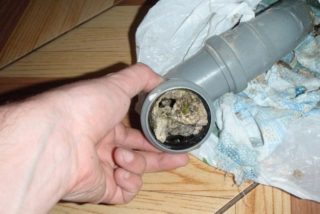 More often formed due to improper installation of the sewer system: a large number of turns, a small diameter of the pipe, low-quality material. Also, the cause may be problems in communication systems located next to sewer pipes or direct wear of the system itself, its damage.
More often formed due to improper installation of the sewer system: a large number of turns, a small diameter of the pipe, low-quality material. Also, the cause may be problems in communication systems located next to sewer pipes or direct wear of the system itself, its damage.
Remedies: In such a situation, only replacing the problem area will help, since regular cleaning will be ineffective.
Siphon blockage
Separately, it is worth highlighting the blockage in the siphon. This is a fairly common problem, especially in the kitchen. It often accumulates food debris, hair and other garbage. This is easy to handle.
A siphon is a bent section of pipe located under the sink. During contamination of this area, an unpleasant odor emanating from the drain and poor discharge of water are usually noted. To eliminate contamination, it is necessary to untwist the knee and remove the accumulated debris. Then rinse, degrease the pipe and reconnect.
If the area of contamination is located a little further than the siphon, you need to use a wire or cable. Do not use them directly through the sink, because there is a high risk of damage to the sink itself and the pipe. In this case, you must first remove the siphon.
Prevention
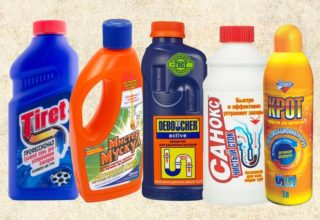 Everyone knows that it’s easier to prevent a problem than to spend a lot of effort and money on fixing it. Timely prevention of pipe contamination will help. We recommend:
Everyone knows that it’s easier to prevent a problem than to spend a lot of effort and money on fixing it. Timely prevention of pipe contamination will help. We recommend:
- Purchase special plastic or metal mesh for the drain hole. They will prevent debris from entering the canal;
- From time to time (at least 1-2 times a year) it is necessary to disassemble and rinse, degrease the pipeline and its connecting elements;
- Open the hot water tap several times a week and flush the system. This simple way will help protect the sewer from large accumulations of fat;
- Under no circumstances should you throw even small wastes, as they can become the basis for the formation of fat plugs.
It is important to remember about chemical cleaning agents that serve as good protection against contamination. This method is effective for the prevention of blockages of organic origin. There is a large selection of similar products that can be divided by consistency: gel, liquid, granular and powder. Their composition varies, but the basis for all options is strong acid or alkali. The most popular product was and remains "Mole", the basis for which is sodium hydroxide. Therefore, it is not recommended to use it for cleaning plastic pipes, since alkali destroys the structure of the material. For such cases, it is better to use gel-like products, they are more gentle.
We must not forget about effective folk recipes. With organic pollution, you can use:
- Vinegar Soda. Pour a glass of soda into the drain hole, add a glass of vinegar. When the foam begins to rise, it is necessary to close the hole and leave for a couple of hours. Then rinse with boiling water. If the water leaves poorly, repeat the procedure;
- Soda with salt. Mix in equal amounts, fall asleep and fill in a small amount of water so that it helps the mixture move to the place of blockage. Leave for 10-12 hours. After the time, rinse with hot water until it starts to pass normally.
- Soda. Best suited to eliminate blockage in the toilet. About 250 g are dissolved in a bucket of hot water and poured into the toilet. We are waiting for 2 hours and rinse off.


